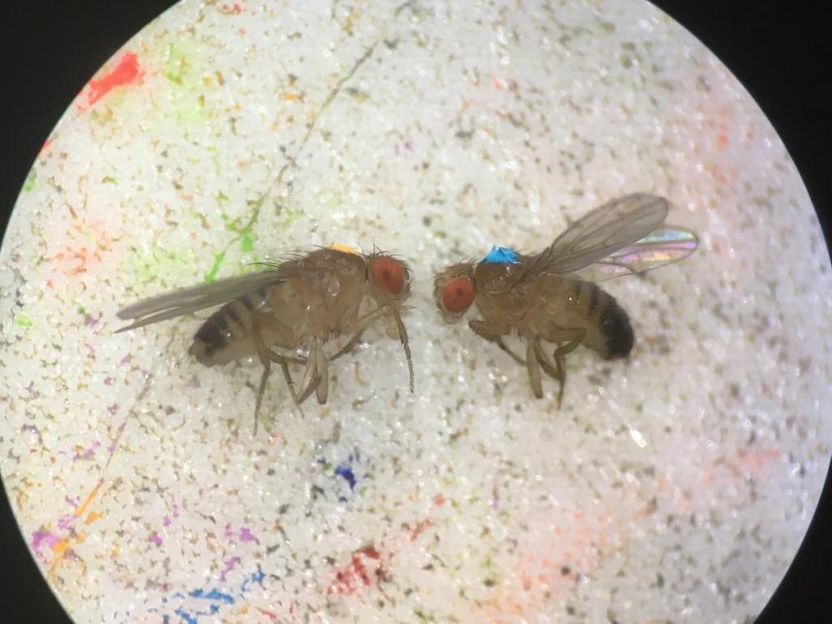Social context matters in spread of disease
"Patient zero" isn't entirely to blame when an infection takes root in a population. According to Rice University scientists, social context in the community has a lot to do with how a disease spreads.

Fruit flies marked with dots of paint in a Rice University lab were used to measure how an infection is spread in communities of different genotypes, with various sex ratios and either a male or female 'patient zero.' The study showed the degree to which social context matters in the spread of disease.
Nick Keiser/Rice University
Rice researchers who study fruit flies found that the ratio of females to males as well as the mating dynamics of the community were strong indicators of how a disease outbreak would progress. While no one genotype was at greater risk than any other, they found males in a community faced a greater risk of infection when they were moderately outnumbered by females.
The study led by Rice Academy postdoctoral fellow Nick Keiser, Rice evolutionary biologist Julia Saltz and Rice community ecologist Volker Rudolf is the first to look at how the behavior of an infectious host and the social factors within a population combine to influence the spread of disease.
Fruit flies are a focus of study in the Saltz lab because of their rapid reproduction and ease of manipulation. A fungus, Metarhizium robertsii, that is fatal to flies and many other insects can be transmitted through close physical contact, including during mating, and in the environment. In this study, the Rice team investigated how this fungus can spread from a single infected individual to its group-mates. "There have been studies on human disease transmission networks that look at group-level and individual-level factors, but not in a way like this where we can actually manipulate those things," Keiser said.
The researchers configured 66 social groups of fruit flies from three genotypes with known behavioral characteristics, including mating frequency, aggregation and aggression, and in five sex ratios ranging from zero to 100 percent female.
"We measured their behaviors as a social group and then we added to each a single infected individual, a male or female patient zero, and allowed them to interact for two hours," Keiser said. Patient zero is the index case or initial patient in the population of the epidemiological investigation.
"Because they all had paint dots on their backs, we could watch their social behaviors, their aggregation with one another and their mating dynamics," Keiser said. "When we separated them to see who became infected and if there were any patterns, we found no genotypic differences in infection risk. We were surprised. We thought there would be a clear link."
Instead, Keiser said, the social context of each group had the most influence on infection rates. "So it's not just your traits, but the traits of the social group that you find yourself in, or maybe that you choose, that influences your infection risk," he said. Another surprise was that males in a female-dominated group were at greater risk. "That is one of the takeaways, and I think it's driven by the males' behaviors," Keiser said. "In a female-biased social group, there's more opportunities for mating. Males increase their courtship behavior and their aggressive behavior with other males, and we think they're more likely to gain this infection just from courtship or from aggressive interactions.
"They change their behavior based on the social environment and inadvertently influence their own infection risk," he said.
Yet another surprise was that when patient zero was female, the risk of disease to males in the community, regardless of their mating history, was four times greater than for females. When patient zero was male, the risk of infection depended more heavily on mating frequency but was identical for both sexes.
"That suggests the identity of that patient zero, the primary case, may even change which mode of transmission is important, which is not something that has been shown before," Keiser said.
Flies that did not appear to mate seemed safest, but were still affected, he said. Only 10 percent of virgin flies became infected, likely from encountering fungal spores on the food patch or from contact with others.
Keiser said previous studies sought to link differences in infection risk solely to the traits of the initial carrier, but that is insufficient. "You're in a social context and your infection risk can be influenced by your social group as well," he said. "We wanted to manipulate those two factors simultaneously.
"The link between host traits and disease risk is interesting, but no individual is an island."
Original publication
Carl N Keiser, Volker H W Rudolf, Elizabeth Sartain, Emma R Every, Julia B Saltz; "Social context alters host behavior and infection risk"; Behavioral Ecology; 2018























































